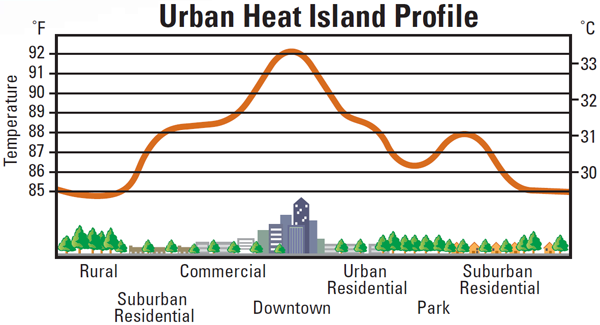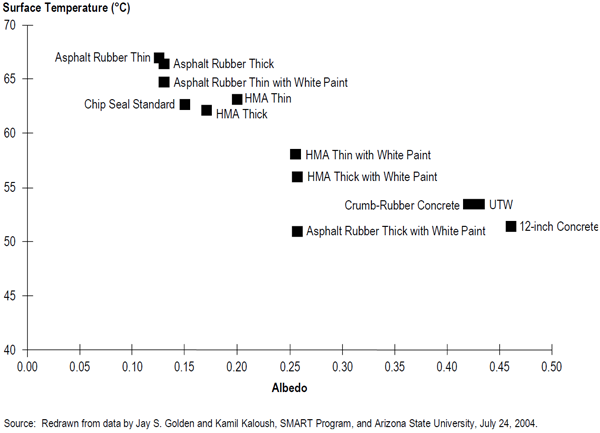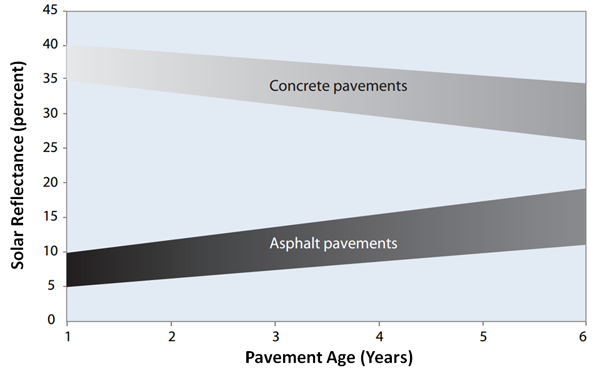Pavement Thermal Performance And Contribution To Urban And Global Climate
Background
The thermal performance of a pavement is defined as the change in its temperature (most often surface temperature) over time as influenced by properties of the paving materials (e.g. albedo, thermal emittance, thermal conductivity, specific heat, and surface convection) and by the ambient environmental conditions (sunlight, wind, air temperature). It can also be influenced by evaporative cooling, which is related to ambient conditions, permeability, and the availability of near surface water (most often a factor if fully pervious pavement systems are used).
Albedo (or solar reflectance) is a measure of the ability of a surface to reflect solar radiation. Solar reflectance values range from 0 (no sunlight reflected) to 1 (all sunlight reflected). Light-colored materials generally have higher solar reflectance values than dark-colored materials, although color alone is not the only indicator of solar reflectance (NCPTC/NCAT 2013).
Emittance is the efficiency with which a surface emits radiant energy, and is defined as the ratio of energy radiated by the surface to the energy radiated by a black body (a perfect absorber and emitter) at the same temperature. Emittance ranges from 0 (no emission) to 1 (perfect emission). Thermal emittance is the emittance of a surface near 300 K (81 °F or 27 °C). Most nonmetallic surfaces have thermal emittances in the range of 0.80 to 0.95. The thermal emittances of dense-graded concrete and asphalt are similar, being in the range of 0.90 to 0.95.
Thermal conductivity is a measure of the ability of a material to conduct or transmit heat. It is the ratio of heat flux (power per unit area) to temperature gradient, and is expressed in units of W/m•K. A material with a high thermal conductivity will transfer heat at a higher rate than a material having a low thermal conductivity. The thermal conductivity of pavement materials varies widely in the reported literature from 0.8 W/m•K to 2.0 W/m•K or greater, with similar values reported for dense-graded asphalt and concrete.
Specific heat is the energy needed to raise a unit mass of a substance by one unit of temperature, typically expressed in units of J/kg•K. The specific heat of dense-graded asphalt and concrete are very similar, being about 900 J/kg•K.
Of these material properties, albedo is the most important with regards to how pavements interact thermally with the environment when exposed to sunlight. Thermal emittance, thermal conductivity, and specific heat capacity of the materials are second order factors (Li et al. 2013).
The Urban Heat Island Effect
On a summer afternoon, urban areas are generally warmer than surrounding rural locations (Jones et al. 1990), as illustrated in figure 1 (EPA 2003). This urban-rural air temperature difference, known as the urban heat island effect (UHIE), is driven by a variety of factors including the prevalence of dark, dry surfaces in cities and heavily urbanized locations.

Figure 1. Heat islands for various areas of development (EPA 2003).
Although urban heat islands (UHIs) are most often thought of as existing in the atmosphere above the city, they actually exist at many different levels, including at the ground/pavement surface, in the air just above the surface (near-surface), and in the ambient air temperatures well above street level, as well as in the atmosphere above the city. In many cases, it is convenient to consider near-surface heat islands, which are characterized by increased ambient air temperature just above the ground/pavement surface, typically at 3 to 6 feet (1 to 2 m) where human outdoor activities occur (Li et al. 2013). Surface and near-surface heat islands can potentially affect human thermal comfort, air quality, and energy use of buildings and vehicles. Atmospheric heat islands can affect communities by increasing summertime peak energy demand, electrical grid reliability, air conditioning costs, air pollution and GHG emissions, heat-related illness and death, and water quality.
Pavement Type and Thermal Performance
Solar reflectance of paved surfaces can be a strong contributor to pavement warming and this warming has the potential to impact the UHIE in those built environments that experience hot weather and are large enough to generate a heat island. Typical albedo values range from 0.04 to 0.16 for asphalt pavements and from 0.18 to 0.35 for concrete pavements (Pomerantz et al. 2003), although the albedo of new concrete can be as high as 0.69 (Marceau and VanGeem 2007). These albedo values are correlated to the color of the pavement whether it is asphalt (black) or concrete (grey or white), but the exposure of aggregates at the surface also plays a role in determining albedo. New asphalt pavements are quite black and have little exposed aggregate and thus have low albedos (typically less than 0.10). This will result in high pavement surface temperatures during hot, sunny periods when not shaded by trees or buildings (Li et al. 2013). With pavement albedo values around 0.10, extreme high pavement surface temperatures of 158 to 176 °F (70 to 80 °C) have been measured on hot summer days in mid-afternoon in Phoenix, Arizona, and up to 158 °F (70 °C) for similar pavements in Davis, California (Li et al. 2013). Figure 2 illustrates how pavement surface temperatures are greatly affected by pavement albedo in Phoenix (Cambridge Systematics 2005). It is noted that pavement albedo changes with time, with the albedo of concrete pavements getting lower and those of asphalt pavements increasing as they age (see figure 3).

Figure 2. Surface temperature and albedo for selected types of pavements in Phoenix, Arizona (note: UTW = ultra-thin whitetopping) (Cambridge Systematics 2005).

Figure 3. Typical pavement solar reflectance of conventional asphalt and concrete pavements over time (EPA 2008).
Practices available to pavement managers, designers, and specification developers that can be used to reduce peak pavement temperatures and might be used to address UHI issues are discussed in Chapter 6 (.pdf) of the Reference Document
References
Cambridge Systematics, Inc. 2005. Cool Pavement Report: EPA Cool Pavements Study - Task 5 (.pdf). Draft Report. Environmental Protection Agency, Washington, DC.
Environmental Protection Agency (EPA). 2003. Cooling Summertime Temperatures: Strategies to Reduce Urban Heat Islands (.pdf). 430-F-03-014. Environmental Protection Agency, Washington, DC.
Environmental Protection Agency (EPA). 2008. Reducing Urban Heat Islands: Compendium of Strategies-Cool Pavements (.pdf). Environmental Protection Agency, Washington, DC.
Jones, P. D., P. Y. Groisman, M. Coughlan, N. Plummer, W. C. Wang, and T. R. Karl. 1990. "Assessment of Urbanization Effects in Time Series of Surface Air Temperature Over Land." Nature. Volume 347, No. 6289. Nature Publishing Group, Macmillan Publishing Ltd., New York, NY.
Li, H., J. Harvey, T. J. Holland, and M. Kayhanian. 2013. "The Use of Reflective and Permeable Pavements as a Potential Practice for Heat Island Mitigation and Stormwater Management." Environmental Research Letters. Vol. 8, No. 01. IOP Publishing, Ltd., Bristol, UK.
Marceau, M. and M. VanGeem. 2007. Solar Reflectance of Concretes for LEED Sustainable Sites Credit: Heat Island Effect (.pdf). PCA R&D Serial No. 2982. Portland Cement Association. Skokie, IL.
National Concrete Pavement Technology Center (NCPTC) and National Center for Asphalt Technology (NCAT). 2013. Quantifying Pavement Albedo - Phase I Final Report: Literature Review and Detailed Work Plan. Project No. DTFH61-12-C-00016. Federal Highway Administration, Washington, DC.
Pomerantz, M., H. Akbari, S. C. Chang, R. M. Levinson, and B. Pon. 2003. Examples of Cooler Reflective Streets for Urban Heat-Island Mitigation: Portland Cement Concrete and Chip Seals. Lawrence Berkeley National Laboratory, Berkeley, CA.

